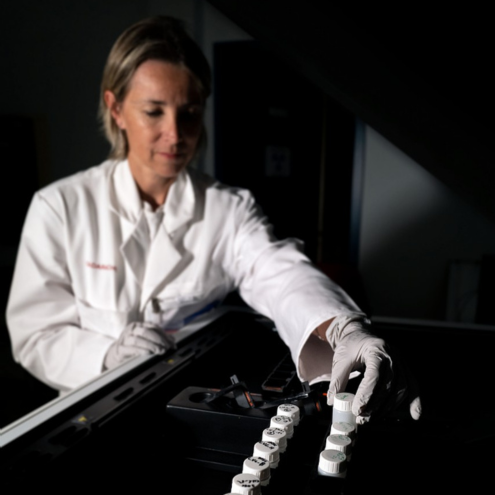
Since 1964, the LARC has been providing its expertise and analytical support in the fields of nuclear reactors, fuels, waste, clean-up, and dismantling; it does this by developing and implementing radiochemical and chemical analyses.
The LARC’s expertise is underpinned by its analytical skills in chemistry and radiochemistry. This laboratory is tasked with developing new chemical and radiochemical analysis methods to reflect the evolving analytical needs at the CEA and its nuclear industry partners (Orano, EDF, Andra, TechnicAtome, etc.). Its teams also work on implementing these methods within the scope of analysing different types of materials (waste, fuel, irradiated and contaminated materials, etc.) and radioactive effluents for R&D programmes, clean-up & dismantling programmes, monitoring & operating programmes, and nuclear industry partner requests.
The skills at the LARC can be applied in a range of fields, such as:
- Pressurised water reactors and the characterisation of their primary and secondary coolants; contribution to studies on secondary system clogging and ion purification using ion exchange resins; characterisation of fission chambers, dosimeters, samples (retrospective dosimetry) for PWR vessel fluency calculations.
- Nuclear fuels and the characterisation of unirradiated fuels, analysis of solutions resulting from the dissolution of shells, etc.
- Waste, clean-up & dismantling, including the characterisation of graphite structures (concrete, steel, etc.) from UNGG reactors; studies on the long-term behaviour of waste (calculating the fraction of leached activity); radiochemical and chemical characterisation to support the classification of waste before its transfer to the appropriate outlet; defining the source term of a facility undergoing dismantling, etc.
The LARC is divided into four units, each with complementary skills:
- Preparative and separation chemistry upstream of the analysis techniques during which the solutions are prepared and solid samples are mineralised, as well as separation chemistry by way of liquid-liquid extraction or by ion exchange chromatography.
- Radiological analysis of α, β, γ and X-ray emitters, such as long-lived radionuclides.
- Mineral and organic chemical analysis, including the calculation of major elements and trace elements, particularly in the organic field.
- Elementary and isotope analysis of trace and ultra-trace elements, specifically looking for long-lived radionuclides and inorganic toxic chemicals.
Equipped with around 30 fume cupboards and gloveboxes, the LARC has the possibility to handle both hardly (or not at all) and highly active samples of varied characteristics. It has the expertise, methods and equipment allowing it to detect at very low detection levels.